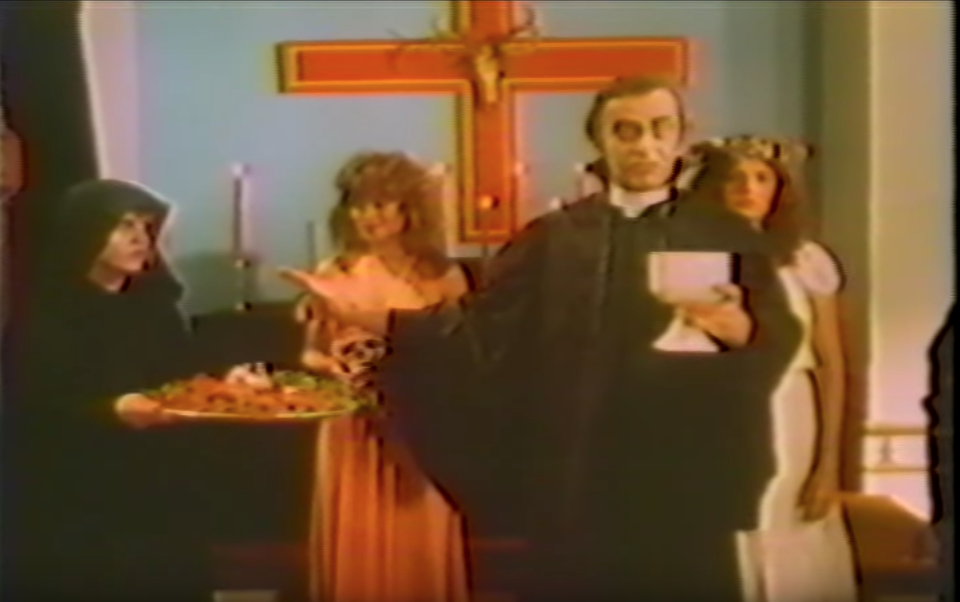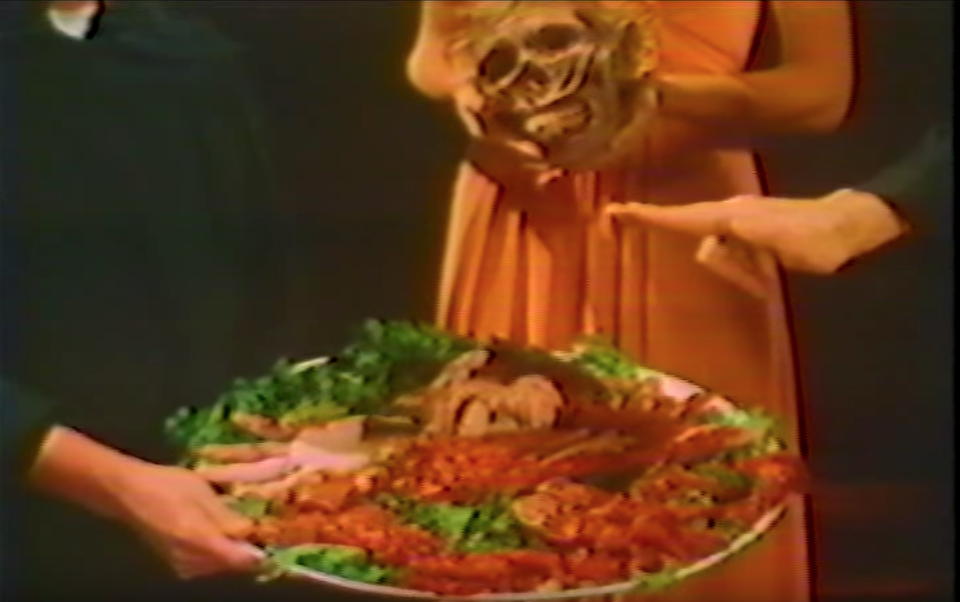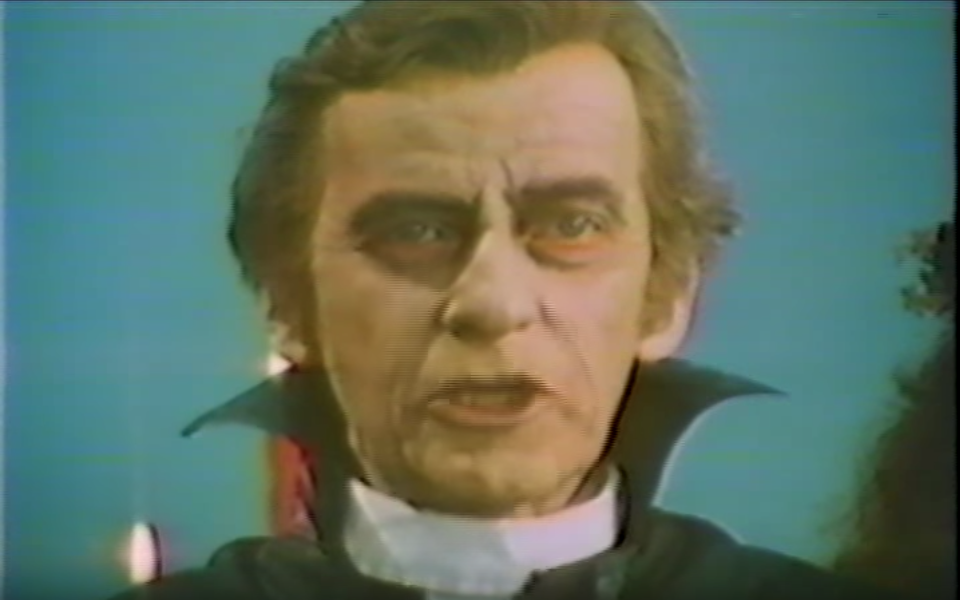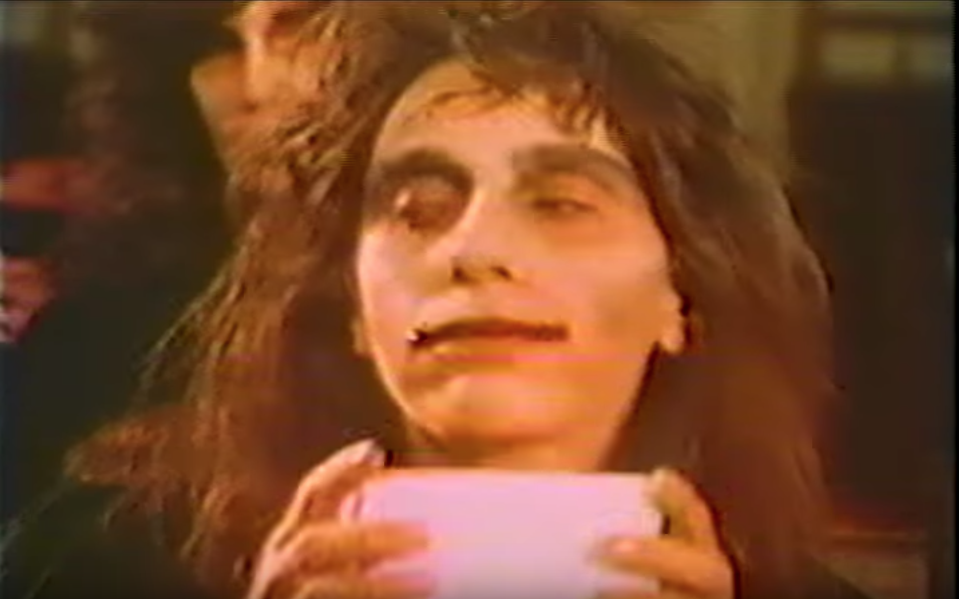The Zombies Are Real
Stills from the trailer for Bruce G. Hallenbeck’s unfinished Cannibal Church, 1983.
An artist looks into history of the zombie archetype, and finds some familiar infrastructures.
Share:
Consider this a public service announcement: the zombies are real. The zombie apocalypse is coming, and it’s more than likely that you and your loved ones will be swept away in a tide of the living dead—a plague-infected, undifferentiated mass that wants only to bite you, infect you, eat you, and initiate you into their horde.
Now that you know, get over it. Frankly, the odds are not in your favor. For the majority of humanity, assimilation is as inevitable as the eradication of civilization’s excesses—$5 Lattes, Kobe steaks, and gold-plated bidets. So fucking give up. Bid farewell to all of the extraneous “stuff” that you, the global consumer, have devoured just as readily as the zombies will now devour you. You may as well go cower in a corner now, and wait for the onslaught of rotting sub-humans that will come, fast or slow, to strip any remaining vestiges of your humanity.
That is, unless you are a survivor: an alpha male/female, ass-kicking, zombie-killing motherfucker who has what it takes to make it in this new world. None of us really want to lose our sense of individuality or our sense of self, to dwell in the mediocrity of the shuffling horde. As scholar John Cussans has noted on his blog, Tracking the Zombie Diaspora: From Sub-human to Post-human, the postmodern zombie can be read as a “base-materialist attack on ideals of collective and individual identity/difference upon which the contemporary liberal-democratic politics of representation is based.” Ultimately, if you can rise above the masses, your ability to simply stay human will make you the veritable star of the post-apocalyptic show.
This postmodern interpretation of zombie phenomena differs from the historical mythological manifestations of zombies that were appropriated from Afro-Caribbean cultures and disseminated into Western cinema. When zombies first entered the sphere of popular folklore they were often an embodiment of a not-so-hidden fear of white civilization confronted with a black exotic. In 1932’s White Zombie, a black “voodoo” doctor (actually Bela Lugosi in blackface) literally and figuratively seeks to possess a white woman. Similarly, I Walked with a Zombie (1943) involves what Cussans describes as a black, male African zombie finding “its uncanny reflection in the white, female ‘European’ somnambulist-hysteric around whose illness the narrative is structured.” Cussans hints at a confluence of racism and sexism in this plot device: “Both appear to be mysteriously controlled by an outside agency, which governs their behavior,” he blogs, “and both are utterly unresponsive to ‘normal’ everyday forms of communication.” Borrowed by Hollywood for their effectiveness in representing America’s fears of increasingly independent, once oppressed populations , these modern zombies provided counterpoints to a rigid social reality that denied not only the humanity of the “other,” but also the possibility of an esoteric and mystical reality that was unconquerable by the rational modern intellect.
Flash forward to Night of the Living Dead, George Romero’s 1968 cult classic, which introduced the model of the zombie apocalypse. Romero’s was a decidedly postmodern, messy, gritty vision, resplendent with the flesh-eating killers that would become the benchmark for all subsequent popular zombie mythology. As the zombie genre gained momentum, so did the zombies themselves. Romero directed five subsequent zombie films in the past 50 years; his satirical vision has meanwhile given way to the sobering portrayals in 28 Days Later (2002), World War Z (2013), and of course the seemingly endless buffet of suffering that is AMC’s The Walking Dead (2010–ongoing). Zombies are so integral to the current vision of the apocalypse that even Cormac McCarthy’s Pulitzer-winning The Road (2006) and its film adaptation—neither of which feature “zombies” as such—are riddled with flesh-eating supporting characters. Writing on the “current horror cycle” in The Journal of Aesthetics and Art Criticism almost 30 years ago, Noël Carroll called this archetype an “exoteric variant of the postmodernist sense that at present our conceptual frameworks are, putatively, precariously unstable.” The rise of globalization and the advancements in information technology that expanded each of our individual worlds simultaneously made us feel as if we played much smaller, much less powerful roles in a universe once operated under the “presuppositions of Pax Americana.”
First a TV in every home, then a computer in every room, and a phone in every pocket: as the dissemination of information increases, and our sense of presence in the world diminishes, the postmodern subject struggles with the feeling of being just another cog in the global machine—part of a wired, zombie mass, linked by a drive to communicate and to consume. The current global economy has generated a new form of waste: human beings made superfluous, unable to fit into the demands of the extraordinary fluidity of 21st-century society. As Paul Santilli has noted in “Culture, Evil, and Horror”—an article published in a 2007 American Journal of Economics and Society issue dedicated to “The Challenges of Globalization”—in the liquid era of digital information, telecommunication, and deregulated markets, there are no fixed territories for manufacture and distribution, and no permanent set of rules or norms to mitigate capitalism’s harsher effects. Santilli compels us to ask, if we, the “multitude,” are the sub-humans, then who are the survivors among us, the antitheses to the “superfluous” zombies of the global capitalistic marketplace? To survive is to be truly human, to be an individual and thus “important” in a world of virtuality and virality. If the horror genre mines the contemporary cultural landscape in search of our collective neuroses, it has found an übermensch in the notion the survivor, a Nietzschean superman among hungry and indiscriminate üntermenschen. In Santilli’s terms, “Globalization creates excess human beings who do not fit into basic categories by which the elite define their own humanity.”
Today it is apparently no longer enough to be wealthy and powerful: to be elite is also to be famous—to tower above the crowd like a gigantic Jeff Koons shiny puppy, to drive through the huddled masses in a gold-plated Maybach like Beyoncé and Jay-Z, designer-clad offspring in tow. Perhaps the most interesting part of the current mythology, then, is that none of that material status shit will matter when the zombies come. Unlike other doomsday visions involving nuclear war, devastating weather, catastrophic interplanetary events, or airborne disease, the zombie apocalypse does not envision an uninhabitable, irreversibly polluted Earth. It doesn’t doom life like an end to drinkable water or an airborne plague could: the zombie’s is an affliction—viral or bacterial—that one can beat down with a baseball bat, decapitate with a machete, or stop with a bullet to the head. If you are smart enough, brave enough, and have that survivor mentality, then you will make it to the other side of this thing. Meanwhile, things are tough but livable, and you don’t have to go in to your boring dead-end job anymore. Instead, you can go claim that Maybach left behind by the departed celebrities, and inhabit their Koons-filled mansions, too.
The zombie apocalypse, then, is the ultimate get-famous-quick reality talent show, a slate-cleaning—even a passive social revolution, of sorts. The narrative turns Americans into pioneers again, endowing them with all the adversity and potential of the early settlers. It creates the “hunting Utopia” described by Danish sociologist Michael Hviid Jacobsen in “The Activating Presence,” published in the Polish Sociological Review in 2006: a universe that stands in contrast to the modern “gardening Utopia.” “Contrary to the collective and long-term focus of the Utopias of modernity,” Jacobson suggests, “hunting Utopias are hyper-individualised and thoroughly short-termed; grand designs or lofty ideals appear as anachronisms in the deregulated atmosphere of liquid modernity. Individuals are now socialized and interpellated primarily if not exclusively as hunters and act like hunters—constantly and with cutthroat-mentality searching for new prey.” What makes the model so appealing is precisely that simplicity: it achieves an indisputable clarity with regard to what “survival” and “achievement” mean. Gone are the intricacies of life in a digital world that requires us to weigh perceived “success” against variables from retirement funds to website hits.
The fascination with zombies has always been connected to the fears and hubris of the dominant consumer class—in the first part of the 20th century, those of a majority-white America faced with, yet still able to overcome and to control, the perceived encroachment of a threatening and primitive other. The survivors of more recent zombie narratives are in the minority—a shift that coincides with an arguably mixed group confronted with another version of globalism, one product of which is a star-making machine that is a cultural phenomenon across industries. Surviving the zombie apocalypse is the natural conclusion of 21st-century fame-seeking; you just need the guts to do it.
Kojo Griffin in an artist based in Atlanta who makes process-based and conceptual series of works that function as “cultural reflections.”He holds a BA in psychology from Morehouse College and an MFA from Georgia State University.



